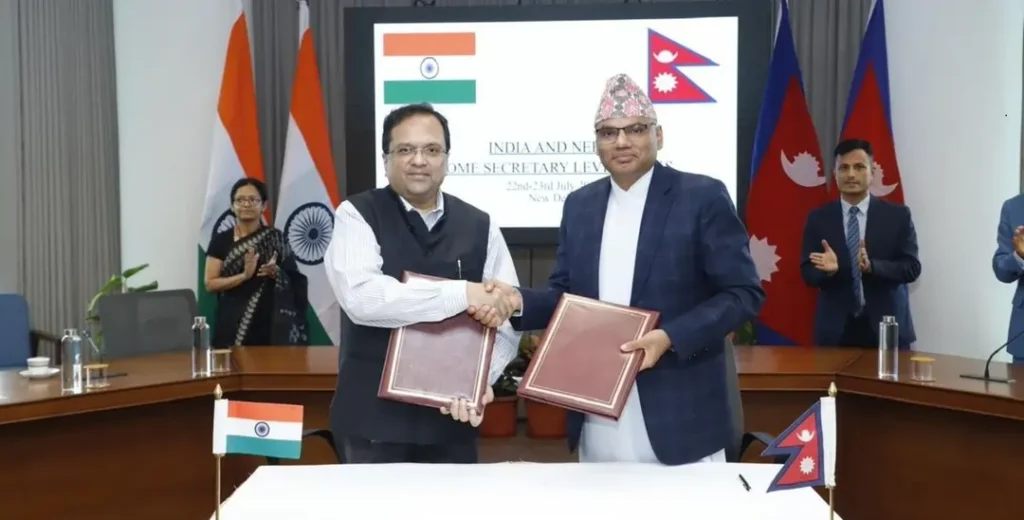New Delhi: In a significant step toward strengthening bilateral ties and combating cross-border crime, India and Nepal have finalized the Agreement on Mutual Legal Assistance (MLA) in Criminal Matters. The announcement came following high-level Home Secretary talks held in New Delhi on July 22, 2025, as confirmed by the Ministry of Home Affairs (MHA) in a statement released on July 23, 2025. Alongside this milestone, both nations have committed to expediting the revision of their outdated 1953 Extradition Treaty, addressing long-standing legal and administrative challenges that have hindered the seamless transfer of criminals across their shared border.

Background of India-Nepal Bilateral Relations
India and Nepal share a unique relationship defined by geographical proximity, cultural ties, and a 1,751 km open border that facilitates the free movement of people and goods. While this open border has fostered economic and social connections, it has also posed significant challenges in managing cross-border criminal activities. The absence of a robust legal framework, particularly in the form of a Mutual Legal Assistance Agreement, has allowed criminals to exploit loopholes, using Nepal as a transit point or safe haven. The Home Secretary-level talks, a recurring platform for addressing such issues, have now paved the way for a formalized mechanism to tackle these concerns.
The Indian delegation at the July 22 talks was led by Union Home Secretary Govind Mohan, while the Nepalese side was headed by Gokarna Mani Duwadee, Home Secretary of the Government of Nepal. The discussions covered a wide range of topics, including bilateral security cooperation, border management, and strategies to combat trans-border crime. The finalization of the MLA Agreement and the commitment to revise the Extradition Treaty mark a turning point in addressing longstanding security challenges between the two nations.
What is the Mutual Legal Assistance (MLA) Agreement?
Mutual Legal Assistance in Criminal Matters is a critical tool for international cooperation in combating crime. It enables countries to request and share evidence, exchange intelligence, and support investigations and prosecutions across borders. The MLA Agreement between India and Nepal formalizes and standardizes procedures for cooperation in criminal matters, providing officials with a clear legal mandate to share critical information and evidence. This leads to faster investigations and prosecutions, enhancing the ability of both nations to address cross-border criminal activities effectively.
India has already signed MLA agreements with 42 countries, including the United States (2005) and Israel (2015), with the Ministry of Home Affairs serving as the central authority for these treaties. The agreement with Nepal fills a critical gap, as Nepal was previously the only neighboring country, aside from Bhutan, without such an arrangement with India. The absence of an MLA Agreement had inadvertently made Nepal an attractive safe haven for criminals, complicating efforts to address trans-border crime.
Benefits of the MLA Agreement
The newly finalized MLA Agreement is expected to bring several key benefits to India-Nepal security cooperation:
- Formalized Cooperation: The agreement establishes a clear legal framework for sharing evidence and intelligence, reducing reliance on informal channels or assurances of reciprocity.
- Faster Investigations: By standardizing procedures, the agreement ensures quicker access to critical information, enabling faster investigations and prosecutions.
- Enhanced Prosecution: The ability to share admissible evidence across borders strengthens the legal process, ensuring that criminals face justice in the appropriate jurisdiction.
- Combating Transnational Crime: The agreement equips both nations to tackle organized crime, terrorism, and other cross-border threats more effectively.
This agreement is particularly significant given the open border between India and Nepal, which has been exploited by criminal groups in the past. For instance, groups like the Indian Mujahideen have used Nepal as a transit or hideout route, with operatives fleeing India via Nepal to third countries. The MLA Agreement will help close these gaps, ensuring that criminals can no longer exploit the lack of a formalized legal framework.
Challenges Faced in the Absence of an MLA Agreement
The absence of a Mutual Legal Assistance Agreement between India and Nepal has posed significant challenges in addressing cross-border crime. These challenges have been compounded by the unique nature of the India-Nepal border and the lack of a modernized extradition framework. Key issues include:
- Open Border Exploitation: The 1,751 km open border between India and Nepal, while a symbol of friendship, has been exploited by criminal elements. Terrorist groups, such as the Indian Mujahideen, have used Nepal as a transit point to evade capture, fleeing to third countries via porous border routes. The lack of a formal MLA Agreement has made it difficult to track and apprehend such operatives.
- Criminal Safe Havens: Without an MLA Agreement, Nepal inadvertently became an attractive safe haven for criminals. For example, Nepalese authorities have occasionally arrested Pakistani nationals involved in fake Indian currency rackets, but the absence of a formal mechanism hindered coordinated action with India.
- Reciprocity Uncertainty: In the absence of a binding treaty, cooperation between India and Nepal often relied on assurances of reciprocity rather than a guaranteed legal framework. This lack of certainty slowed down investigations and created inconsistencies in handling cross-border cases.
The finalization of the MLA Agreement addresses these challenges by establishing a robust legal framework for cooperation, ensuring that both nations can work together seamlessly to combat crime.
Revising the 1953 Extradition Treaty
In addition to the MLA Agreement, India and Nepal have agreed to expedite the revision of their 1953 Extradition Treaty, which is widely regarded as outdated. Extradition is defined as the surrender by one state to another of a person accused or convicted of crimes that are justifiable in the courts of the requesting state. In India, the Ministry of External Affairs (MEA) serves as the central authority for extradition matters.
The 1953 treaty, while historically significant, has not kept pace with modern challenges in cross-border crime, including terrorism, organized crime, and cybercrime. Legal and administrative hurdles have often delayed or prevented the smooth transfer of criminals between India and Nepal. The commitment to revise this treaty reflects both nations’ recognition of the need for a modernized framework to address contemporary security threats.
During the Home Secretary-level talks, both sides expressed their intent to conclude the revised extradition treaty at the earliest possible date. This revision is expected to streamline the extradition process, making it easier to transfer criminals and fugitives while ensuring compliance with international legal standards.
Broader Discussions at the Home Secretary-Level Talks
The Home Secretary-level talks on July 22, 2025, covered a wide range of issues beyond the MLA Agreement and the Extradition Treaty. The discussions focused on strengthening bilateral security cooperation and improving border management. Key areas of focus included:
- Repair and Maintenance of Boundary Pillars: Both sides discussed the need to maintain and repair boundary pillars along the 1,751 km border to ensure clear demarcation and prevent disputes.
- Trans-Border Criminal Activities: The talks addressed strategies to combat cross-border crimes, including terrorism, smuggling, and human trafficking.
- Border District Coordination Committees: These committees play a crucial role in coordinating local-level efforts to manage the border and address security concerns.
- Strengthening Border Infrastructure: Both nations agreed to enhance border infrastructure, including Integrated Check Posts, roads, and railway networks, to facilitate legitimate trade and movement while improving security.
- Capacity Building for Security Institutions: The talks emphasized the need to empower and build the capacity of security-related institutions in both countries.
- Disaster Risk Reduction and Management: Given the shared vulnerability to natural disasters, such as earthquakes and floods, both sides explored ways to strengthen cooperation in disaster risk reduction and management.
These discussions reflect the multifaceted nature of India-Nepal security cooperation, which extends beyond criminal justice to encompass broader issues of border management and disaster preparedness.
Future Steps and Next Talks
Both India and Nepal welcomed the finalization of the MLA Agreement and expressed optimism about concluding the revised Extradition Treaty soon. To maintain momentum, the two sides agreed to hold the next round of Home Secretary-level talks in Nepal at a mutually convenient date. These talks will likely build on the progress made in New Delhi, focusing on further strengthening bilateral ties and addressing emerging security challenges.
Implications for India-Nepal Relations
The finalization of the MLA Agreement and the commitment to revise the Extradition Treaty mark a significant milestone in India-Nepal relations. These agreements address longstanding gaps in legal cooperation, enabling both nations to tackle cross-border crime more effectively. By formalizing procedures for evidence sharing and extradition, the agreements will enhance the ability of law enforcement agencies to investigate and prosecute criminals, reducing the likelihood of Nepal being used as a safe haven.
Moreover, the agreements signal a broader commitment to deepening bilateral security cooperation. The open border, while a cornerstone of India-Nepal friendship, has long been a double-edged sword, facilitating both legitimate movement and criminal activities. The MLA Agreement and the revised Extradition Treaty provide a framework for managing these challenges while preserving the spirit of openness and cooperation that defines the relationship.
Conclusion
The finalization of the Mutual Legal Assistance Agreement and the push to revise the 1953 Extradition Treaty represent a landmark achievement in India-Nepal relations. By addressing critical gaps in legal cooperation, these agreements pave the way for faster investigations, smoother extraditions, and more effective responses to cross-border crime. The Home Secretary-level talks held on July 22, 2025, underscore the commitment of both nations to strengthen bilateral security ties and manage their shared border effectively. As India and Nepal move forward with these initiatives, they are setting a strong foundation for a safer, more secure region, built on mutual trust and cooperation.
FAQs
Que: What is the India-Nepal Mutual Legal Assistance (MLA) Agreement finalized in 2025?
The India-Nepal Mutual Legal Assistance Agreement in Criminal Matters, finalized on July 23, 2025, is a bilateral treaty that formalizes cooperation between the two countries in combating crime. It enables the sharing of evidence, intelligence, and support for investigations and prosecutions. The agreement provides a clear legal framework for officials to collaborate, ensuring faster investigations and prosecutions. The Ministry of Home Affairs in India serves as the central authority for this agreement.
Que: Why was the 1953 India-Nepal Extradition Treaty considered outdated, and what steps are being taken to address this?
The 1953 Extradition Treaty is seen as outdated due to its inability to address modern challenges like terrorism, organized crime, and cybercrime. Legal and administrative hurdles have hindered the smooth transfer of criminals between India and Nepal. During the Home Secretary-level talks on July 22, 2025, both nations agreed to expedite the revision of this treaty to create a modernized framework that facilitates efficient extradition while complying with international legal standards.
Que: What challenges did the absence of an MLA Agreement create for India and Nepal?
Without an MLA Agreement, India and Nepal faced several challenges:
Reciprocity Uncertainty: Cooperation relied on informal assurances of reciprocity, leading to delays and inconsistencies in handling cross-border cases.
Open Border Exploitation: The 1,751 km open border was exploited by groups like the Indian Mujahideen, who used Nepal as a transit or hideout route to evade capture.
Criminal Safe Havens: Nepal, lacking an MLA with India (unlike other neighbors except Bhutan), inadvertently became a safe haven for criminals, such as those involved in fake Indian currency rackets.
Que: What were the key topics discussed during the India-Nepal Home Secretary-level talks on July 22, 2025?
The talks, led by Union Home Secretary Govind Mohan (India) and Home Secretary Gokarna Mani Duwadee (Nepal), covered:
Capacity building for security institutions and cooperation in disaster risk reduction and management.
Finalization of the MLA Agreement.
Revision of the 1953 Extradition Treaty.
Strengthening bilateral security cooperation and border management.
Repair and maintenance of boundary pillars along the 1,751 km border.
Combating trans-border criminal activities.
Enhancing border infrastructure, including Integrated Check Posts, roads, and railways.
Que: How will the MLA Agreement and revised Extradition Treaty benefit India and Nepal?
The MLA Agreement standardizes procedures for sharing evidence and intelligence, enabling faster investigations and prosecutions. It closes gaps exploited by criminals, particularly along the open border. The revised Extradition Treaty will streamline the transfer of accused or convicted criminals, addressing modern security threats like terrorism and organized crime. Together, these agreements strengthen bilateral security cooperation, reduce criminal safe havens, and enhance the ability to combat cross-border crime effectively.

